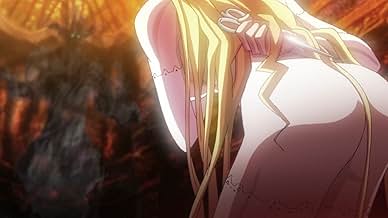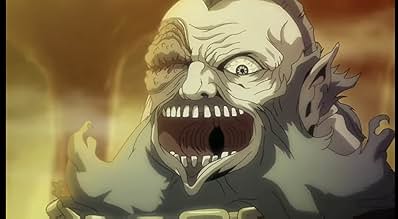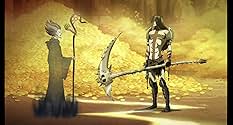Füge eine Handlung in deiner Sprache hinzuDante journeys through the nine circles of Hell -- limbo, lust, gluttony, greed, anger, heresy, violence, fraud and treachery -- in search of his true love, Beatrice.Dante journeys through the nine circles of Hell -- limbo, lust, gluttony, greed, anger, heresy, violence, fraud and treachery -- in search of his true love, Beatrice.Dante journeys through the nine circles of Hell -- limbo, lust, gluttony, greed, anger, heresy, violence, fraud and treachery -- in search of his true love, Beatrice.
- Regie
- Drehbuch
- Hauptbesetzung
- Dante
- (Synchronisation)
- Beatrice
- (Synchronisation)
- Lucifer
- (Synchronisation)
- Virgil
- (Synchronisation)
- Alighiero
- (Synchronisation)
- Bella
- (Synchronisation)
- Charon
- (Synchronisation)
- …
- King Minos
- (Synchronisation)
- …
- The Avenger
- (Synchronisation)
- Farinata
- (Synchronisation)
- (as Grant Albrecht)
- …
- Female Prisoner
- (Synchronisation)
- Nessus
- (Synchronisation)
- …
- Female Sinner
- (Synchronisation)
- …
- Lust Minion #1
- (Synchronisation)
- …
- King Richard
- (Synchronisation)
- …
- Plato
- (Synchronisation)
- Child
- (Synchronisation)
- (as Shelley O'Neill)
Empfohlene Bewertungen
Like most anime adapted from video games, the story is a straight forward tale for which its only purpose is to conveniently propel Dante from one level of Hell to the next. True to the spirit of a video game, each level of Hell has its own blade fodder troops and "stage boss". Throughout the linear and somewhat simplistic main story, the more intriguing back-story is fleshed out in flashbacks. It seemed that Lucifer challenged Beatrice to a bet that Dante would never betray her trust or fall into sin while he was away fighting the war. Naturally The pure-hearted Beatrice, so full of faith in her husband, accepted that bet with her soul as the prize. As the show progresses and as Dante gets nearer to his goal, Lucifer delights in utterly shattering Beatrice's faith first in God, then in mankind and ultimately in her husband who's sinful past deeds are stitched to his chest in the form of a blood red cross.
Animated by 5 animation studios and 6 directors, Dante's Inferno no doubt suffers from some inconsistency. Film roman's work opens the movie and where it lacks in artistic detail, it makes up for it by having the most fluid character movements in the whole film. Designs maintain the simpler contemporary western animation style similar to other Direct-to-Video animated movies like Planet Hulk yet preserves the game's dark gritty setting. Upon entering the level of Limbo, Studio Manglobe(famous for their work on Samurai Champloo) takes over animation with director Shukou Murase (whose works include animation design for Gundam Wing and directing the anime series Ergo Proxy) at the helm. Boasting the most incredible amount of art detail, a nightmarish Gothic feel and great looking character designs, Manglobe's segment is impressive to behold. No small cutesy characters, big kawaii eyes or bright cheery colors that so many Japanese productions suffer from.
From gritty Gothic the show transits to the amazing animated visuals of Dong Woo Animation (justice League Unlimited, Masters of the Universe 2002) and director Jong Sik-Nam(Batman Gotham Knight: Deadshot). Balancing beautiful artwork with slick animation, a leaner meaner Dante slashes through the levels of "Lust", "Gluttony" and "Anger" which are rendered in a stylish American graphic novel look not unlike 2009's "Tales of the Black Freighter" from Warner. Sadly from here on, the animation takes a slow dive in quality.
JM animation handles the next 2 segments and one thing they can never get right is the mouth movements of characters. The first segment, taking place in the level of "Violence", boasts a buff, muscular Dante and a stylized design more suited for a Saturday morning action anime than a dark gritty horror piece. At this point even the story, which started off like a blazing bonfire, starts to sputter and ebb. This is followed by the level of "Fraud", supposedly the start of the film's climax. But by now, the story has descended so much into a brainless hack and slash that the ultimate resolution to the climax is a big letdown. Complex and intriguing themes that were hinted upon earlier in the film are discarded in favor of moving the action along. For example, the running theme of repentance and forgiveness is trivialized into a kind of "magic spell" that can redeem lost souls by waving a silver cross at them.
Lastly, Dante's Inferno goes out with a sad fizzle thanks to a sub-par rush job by Production I.G. It boggles the mind how the studio responsible for Ghost in The Shell, Sky Crawlers and other beautifully animated productions could turn up such a thing. The final showdown with Lucifer is an appropriate closure for Dante's spiritual journey but the animation presented is only mediocre, the artwork simplistic and the character designs, laughable. Dante is now a disproportionately wide oaf who looks more fat than muscular and Lucifer himself conjures up memories of some lost Digimon.
Not many may appreciate the unnecessarily convoluted narrative or the inconsistent visual styles. The characters tend to fall into hero/damsel/villain/hero's guide stereotypes even though the stellar voice cast play their roles with such burning passion. On first viewing, Dante's Inferno may satisfy fans of violent horror anime like Vampire Hunter D Bloodlust or Hellsing. The bloody action never fails to please though the more conservative types may be put off by the religious musings and sexually graphic visuals (that level is not called "Lust" for nothing). It might seem like all style over substance at first but if one were to read in between the lines, Dante's Inferno presents a tragic tale of love, loss, faith and redemption; unoriginal themes for sure but themes that anyone can easily relate to.
Dante's original, one of the great epics of world literature, has been the inspiration of much work by writers and artists down the centuries. IMDb lists four or five screen works with the title. Animated versions have been rare, although no doubt there's a comic book version lurking somewhere. Such is the nature of things that this present version appears in a year along with a rival animated production titled more succinctly 'Dante's Inferno' - one shorter in length, but apparently superior to this in its fidelity to the original. The most notable live-action version has always been that of 1935 with Spencer Tracy, an even freer adaptation than the one we have here, in which the horrendous visions are compressed into 10 minutes of a much longer narrative.
By contrast, the present version spends most of its running time on these elements, depicting at length Dante's journey through the nine circles of hell to reach his beloved Beatrice. Perhaps sensing a need for variety between the titanic battles that this progress involves, Dante's Inferno: An Animated Epic breaks up the hero's progress with several flashbacks, not in the original, during which the true state of affairs and Dante's real moral stature becomes more and more explained.
The character of Beatrice has been changed as part of this new narrative device, giving her a more dynamic role in the narrative as well as providing the romantic core. Whether or not Dante would have appreciated his ideal love appearing briefly as the bride of Lucifer, or his reflective protagonist-self metamorphosing into an axe-wielding warrior figure more Conan than Christian, one can only conjecture; but a target audience will respond to the changes. Only Dante's guide, the poet Virgil, keeps some of his original quiet dignity.
Given the EA game standing behind the release, it's no surprise that Dante's Inferno: An Animated Epic has action and a plot structure more reflective of that more commercial source than Dante's leisurely writing. Much of the moral depth and complexity of the book has been jettisoned thereby in favour of arcs of swift movement. The original contained a more sophisticated and extended version of damnation than the mere nine circles of doom rather simplistically imagined here, each becoming just another test for our hero to reach, then duly pass through. The original's spiritual shock and awe has been replaced by a gamer's inevitable level-creep, where it is never really in doubt that Hell is likely to be overcome. It's a considerable reduction of the medieval original's salutary purpose, even if the ending of the film attempts to have it both ways.
The original Inferno, one part of the three-part Divine Comedy, makes particular use of allegory throughout, in ways an educated medieval reader would be expected to follow. Understandably feeling that allegory is not something that modern audiences will sit through at great length without growing restless, and with the imperatives of a game franchise to support, one imagines Dante's Inferno: An Animated Epic was always going to be obliged to substitute breathless action for contemplation, sketched in typical anime style.
Suffice to say that the animation on offer here is certainly vivid even if, by comparison to the Shrek-like pictorial quality of the game (a trailer for which is helpfully included as an extra on the disc), the line-drawn work seems dated in style. Some, incidentally, have noticed a lack of continuity in the rendering of Dante's features. At first I thought each of the nine circles cleverly had its own subtle visual identity, but no: it's just because eight studios and directors from America, North Korea and Japan all had input. It's an inconsistency that's a little distracting; one indication perhaps of a rushed production, tied to release dates elsewhere.
Japanese fantasy anime and manga have a tradition of dealing with the matter of monsters and shadow worlds, often with their own original mythologies and shock tactics - so much so that they sometimes give censors pause for thought. It was one reason why they acquired such a cult following. But there's no tentacle horror intruding here; no stomach-churning changes of form, no real depravity, while the sexual content is reduced to occasional titillation.
Hell, one would hope, ought to be the most alarming and appalling spectacle of all, an updated warning to all who behold it, a moral imperative to reform, a presentation of the most terrible of terrors. But the horrors of Dante's Inferno: An Animated Epic leave us frankly un-aghast and un-chastened. Whether or not the creators have been constrained by deference to the august original or just the mass-market demands of their sponsors is hard to say; but for a real walk on the dark side you would be better off with something like the now elderly Devil Man (aka: Debiruman) or, most memorably, the notorious Urotsukidôji.
Wusstest du schon
- WissenswertesGraham McTavish and Vanessa Branch were the voices of Dante and Beatrice in the video game and also provided the voices of Dante and Beatrice in the film, which was released simultaneously with the video game.
- Zitate
Lucifer: Even the purist souls can be corrupted. Dante is not the man you once knew.
Beatrice: You did this to him. You corrupted his heart.
Lucifer: I've had no need to influence humanity for many millennium my dear. I simply introduced sin. Man is the one who has spread it like a disease; cultivating it, empowering it.
Beatrice: It is not our fault, none of it. Man is good.
Lucifer: No, you don't understand. The earth is another form of hell, and men are its demons.
- VerbindungenFeatured in AniMat's Classic Reviews: Dante's Inferno: An Animated Epic (2015)
Top-Auswahl
- How long is Dante's Inferno: An Animated Epic?Powered by Alexa
Details
- Erscheinungsdatum
- Herkunftsländer
- Sprachen
- Auch bekannt als
- Dante's Inferno: An Animated Epic
- Produktionsfirmen
- Weitere beteiligte Unternehmen bei IMDbPro anzeigen
- Laufzeit1 Stunde 24 Minuten
- Farbe
- Seitenverhältnis
- 1.78 : 1
Zu dieser Seite beitragen










































